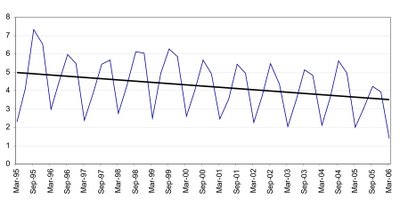One would expect that the money velocity should have gone up significantly in Armenia over the last decade or so. Money velocity is basically a measure of how fast each dram in circulation turns over in the economy. When businesses and consumers are confident, they are willing to spend their money faster, which leads to an increase in velocity, and vice-versa. Introduction of ATM machines and various electronic payment systems in turn enhance the circulation of money and increases its velocity.
However, the existing data suggest that the money velocity of Dram, measured as the ratio of
GDP to
monetary base, has a downward trend. As the figure below suggests, there are also large seasonal fluctuations.

Are there any studies exploring the reasons for this trend?
 Are there any studies exploring the reasons for this trend?
Are there any studies exploring the reasons for this trend?
3 comments:
Is it possible that the economy is growing faster than the official statistics indicate?
Would that explain the downward trend?
If you plot log levels of GDP and monetary base for the period, it becomes obvious that GDP has been growing at a slower rate than monetary base, therefore money velocity exhibits a downward trend. In addition to the reason mentioned by David, another reason could be the dollarization of the economy in the earlier years of the period in question. In mid-90s, there was more foreign currency in circulation and more transactions were concluded in foreign currency than now. Overall, this might have led to the faster expansion of Dram monetary base compared to the GDP over this period.
Post a Comment